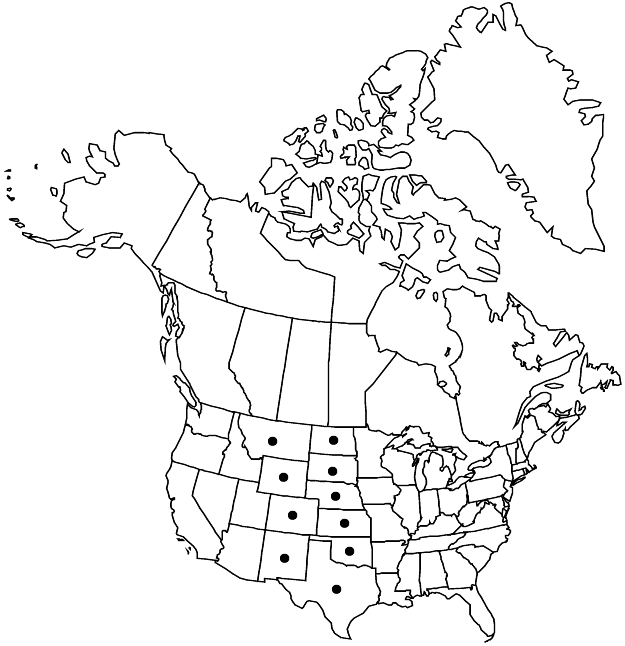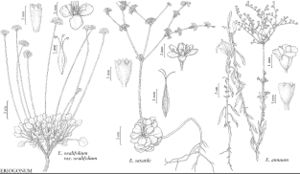Eriogonum annuum
Trans. Amer. Philos. Soc., n. s. 5: 164. 1835.
Herbs, 5–20 × 5–10 dm, grayish. Aerial flowering stems slender, 4–10(–15) dm, floccose to densely tomentose. Leaves: petiole (rosette) 0.3–1.2 cm, or petiole (cauline) 0.2–0.5 cm, tomentose to floccose; blade oblanceolate to oblong, 1–7 × 0.3–1.5 cm, densely tomentose abaxially, floccose adaxially not thickened and auriculate-subclasping proximally; margins entire or slightly revolute. Inflorescences 3–10 × 2–7 cm; bracts triangular, 1–4 mm. Peduncles 0.1–0.5 cm, tomentose to floccose. Involucres turbinate to campanulate, 2.5–4 × 2–3 mm, tomentose to floccose abaxially, glabrous adaxially; teeth 5–6, 0.4–1 mm. Flowers 1–2.5 mm; perianth white or cream to rose; tepals: those of outer whorl obovate, 1–2 × 0.9–1.5 mm, those of inner whorl narrowly ovate to oblong, 1.5–4 × 1.2–1.8 mm; stamens usually included, 1–2 mm. Achenes 1.5–2 mm. 2n = 40.
Phenology: Flowering Apr–Nov.
Habitat: Sandy flats, slopes, dunes, and banks, mixed grassland, oak and conifer woodlands
Elevation: (0-)100-1900(-2300) m
Distribution

Colo., Kans., Mont., Nebr., N.Mex., N.Dak., Okla., S.Dak., Tex., Wyo., Mexico (Chihuahua).
Discussion
Eriogonum annuum is widespread and common to locally abundant or even weedy on the Great Plains of the central United States and extreme north-central Mexico. It was collected in Sherburne County, Minnesota, in 1982, but that population did not persist. The species was recently found as an introduction at Sandy Hook in Monmouth County, New Jersey (Snyder & McArthur s.n., NY), but its fate there remains to be determined. Unfortunately, this weedy species recently has been introduced into northern Arizona as a roadside wild flower. C. L. Perez et al. (1998) have demonstrated that the seed bank can be rich in seeds of this species, but germination rates are low.
The Lakota people traditionally used the annual wild buckwheat as an aid in the treatment of sore mouths in children, seemingly in association with teething (D. J. Rogers 1980). Leaves were used to stain buffalo and deer hides by the Kiowa (P. A. Vestal and R. E. Schultes 1939). Vestal (1952) stated that the species was considered a “life medicine” by the Navajo (Diné) people; it was used also for protection against witches. It is likely that E. annuum was obtained by the Navajo through trade, but it might have been grown locally in historic times where the species recently has been reintroduced.
Selected References
None.
